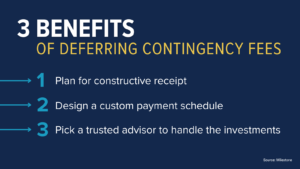
In this blog we explain the benefits of deferring contingency fees as related to single-event, multi-party, and mass tort matters, featuring insights from Laura Baroudi (Fetto), Director of Settlement Planning at Milestone, an innovator in providing post-settlement solutions for mass tort and multi-party litigation.
If you’re an attorney receiving contingency fees and haven’t yet considered a deferral, you’re missing out on an advantageous financial strategy. A deferral solution allows you to manage tax-burdens, maximize cash flow, and garner growth on your monies.
Fee deferral is an optimal solution to leverage control over your fees by designing a preferred payment schedule set to begin immediately or in the future. Whether you handle single-event, multi-party, or mass tort matters, this financial strategy can greatly benefit you and your firm.

Step 1 – Avoid Constructive Receipt
To maintain your ability to defer a contingency fee, you must not take the funds into your operating or personal bank account. Doing so would mean you have constructively received this fee for income purposes. A qualified settlement fund (468b trust) is a great stepping stone to ensure the possibility of deferral is protected. Specified language within your settlement documents is also crucial to ensuring funds aren’t constructively received.
Benefit: Decide how much of your contingency fee(s) you want to realize as income, and how much you want to defer.
Step 2 – Design Your Customized Payment Schedule
Your fees intended for deferral must be attached to a fixed and predetermined payment schedule. Work with an expert, financial advisor, and/or CPA to determine what your preferred distribution schedule should look like. There’s flexibility when it comes to frequency of payments and duration of payments, so taking your full financial picture into account is important. Once your deferral account has been funded, this schedule cannot be changed.
Benefit: Set future distributions based on life’s milestones (ex., college tuition, vacation home purchase, retirement) and/or smooth out the peaks and valleys of cash flow to you or your firm while spreading out your tax burden.
Step 3 – Pick a Trusted Financial Advisor
A financial advisor of your choosing will handle the investment allocation on your deferral account. While a third-party assignment company acts as the holder of assets and obligor to make future periodic payments, a specified advisor will be the one to develop a proper portfolio allocation. You have the freedom to choose the individual managing this aspect of your deferral. If you don’t have someone in mind or want to diversify, most trustworthy assignment companies work alongside renowned advisors in the space and can make recommendations.
Benefit: The flexibility to pick your own advisor enables you to have someone you already know and trust managing your funds.
Attorneys deal with so many unknowns in their day-to-day: handling ongoing caseloads, estimating the timing of settlements, managing uneven cash flows, etc. Take control of your financial picture by building a custom distribution schedule with your contingency fees.
Financing Solutions Tailored to Your Law Firm's Needs
Discover how leading contingency fee law firms are succeeding with financing solutions from Esquire Bank. Learn how your law firm can leverage its contingent case inventory to gain access to capital so you can invest in key business areas and drive sustainable law firm growth.
Meet with Esquire Bank
The information provided in this blog is provided for general informational purposes only and is not intended as, and should not be relied on for, law firm operations, tax, legal or accounting advice. . Some of the information may not be applicable or appropriate for all law firms. Please consult your own tax, legal and accounting advisors as appropriate.
Continue Reading
- Life Cycle Stage: Educated - Best Practices
- Content Tier: silver
- Content Type: blog




